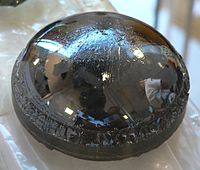
Photo from wikipedia
Abstract Molybdenum disulfide (MoS2) is a promising hydrogen evolution reaction (HER) electrocatalyst, while several challenges still remain to obtain high efficient activity, due to low conductivity, weak active sites and… Click to show full abstract
Abstract Molybdenum disulfide (MoS2) is a promising hydrogen evolution reaction (HER) electrocatalyst, while several challenges still remain to obtain high efficient activity, due to low conductivity, weak active sites and poor stability of pristine MoS2. Here, we demonstrate modulation of electron structures in 3D hollow MoS2 for increasing intrinsic conductivity and activating basal planes through heteroatom doping to achieve superior HER performances. The oxygen doped hollow MoS2 nanoarchitectures (H-O-MoS2) assembled from nanosheets are constructed by oil-water two-phase method and anion exchange reaction. The H-O-MoS2 presents overpotential of 207 mV at current density of 10 mA cm−2 and Tafel slope of 65 mV dec-1, which are much lower than hollow MoS2 (H-MoS2) and oxygen doped solid MoS2 (S-O-MoS2). Based on density functional theory (DFT) calculations, electron structures of MoS2 including electron density, band structure and density of state are modulated through oxygen doping, leading to highly activated basal surfaces and enhanced conductivity. Compared with H-MoS2, hydrogen adsorption of Gibbs free energy of H-O-MoS2 is reduced to 1.11 from 2.15 eV, enhancing hydrogen adsorption-desorption rate. The concept of our work combines advantages of hollow structures and electron structure modulation by oxygen doping to greatly enhance HER of MoS2, which could be extended to other 3D metal dichalcogenides catalysts for water-splitting.
Journal Title: Colloids and Surfaces A: Physicochemical and Engineering Aspects
Year Published: 2020
Link to full text (if available)
Share on Social Media: Sign Up to like & get
recommendations!